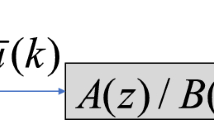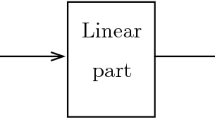Abstract
Aiming at the identification problems arising for fractional-order Hammerstein-Wiener system parameter coupling, namely, the difficulty of estimating the fractional order, low algorithm accuracy and slow convergence, an alternate identification method based on the principle of multiple innovations is proposed. First, a discrete model of a fractional-order Hammerstein-Wiener system is constructed. Second, an information matrix composed of fractional-order variables is used as the system input, combined with the multi-innovation principle, and the multi-innovation recursive gradient descent algorithm and the multi-innovation Levenberg-Marquardt algorithm are used to alternately estimate the parameters and fractional order of the model. The algorithms are executed cyclically and alternately presuppose each other. Finally, the convergence of the overall algorithm is theoretically analyzed, and the fractional-order Hammerstein-Wiener nonlinear system model is used to carry out numerical simulation experiments to verify the effectiveness of the algorithm. Moreover, we apply the proposed algorithm to an actual flexible manipulator system and perform fractional-order modeling and identification with high accuracy. Compared with the methods proposed by other scholars, the method proposed in this paper is more effective.









Similar content being viewed by others
References
Matlob MA, Jamali Y (2019) The concepts and applications of fractional order differential calculus in modeling of viscoelastic systems: a primer. Crit Rev Biomed Eng 47(4):249–276
Yavuz M, Sene N, Yıldız M (2022) Analysis of the influences of parameters in the fractional second-grade fluid dynamics. Mathematics 10(7):1125
Failla G, Zingales M (2020) Advanced materials modelling via fractional calculus: challenges and perspectives. Phil Trans R Soc A 378(2172):20200050
Qureshi S, Yusuf A, Shaikh AA, Inc M, Baleanu D (2019) Fractional modeling of blood ethanol concentration system with real data application. Chaos: An Interdisciplinary Journal of Nonlinear Science 29(1):013143
Shulin L, Naxin C, Yan L et al (2017) Modeling and state-of-charge estimation of automotive lithium-ion batteries based on fractional-order theory. Chin J Electrotechnical Technol 32(4):189–195
Jajarmi A, Baleanu D (2021) On the fractional optimal control problems with a general derivative operator. Asian Journal of Control 23(2):1062–1071
Wang S, Takyi-Aninakwa P, Jin S et al (2022) An improved feedforward-long short-term memory modeling method for the whole-life-cycle state of charge prediction of lithium-ion batteries considering current-voltage-temperature variation. Energy 124224
Wang S, Jin S, Bai D, Fan Y, Shi H, Fernandez C (2021) A critical review of improved deep learning methods for the remaining useful life prediction of lithium-ion batteries. Energy Rep 7:5562–5574
Zou C, Zhang L, Hu X, Wang Z, Wik T, Pecht M (2018) A review of fractional-order techniques applied to lithium-ion batteries, lead-acid batteries, and supercapacitors. J Power Sources 390:286–296
Zúñiga-Aguilar CJ, Gómez-Aguilar JF, Romero-Ugalde HM, Jahanshahi H, Alsaadi FE (2022) Fractal-fractional neuro-adaptive method for system identification. Eng Comput 38(4):3085–3108
Xiong R, Tian J, Shen W et al (2018) A novel fractional order model for state of charge estimation in lithium ion batteries. IEEE Trans Veh Technol 68(5):4130–4139
Burkovska O, Glusa C, D’elia M (2022) An optimization-based approach to parameter learning for fractional type nonlocal models. Comput Math Appl 116:229–244
Zhang Q, Wang H, Liu C (2021) Identification of fractional-order Hammerstein nonlinear ARMAX system with colored noise. Nonlinear Dynamics 106(4):3215–3230
Zhang Q, Wang H, Liu C (2022) MILM hybrid identification method of fractional order neural-fuzzy Hammerstein model. Nonlinear Dynamics:1–15
Rahmani MR, Farrokhi M (2018) Identification of neuro-fractional Hammerstein systems: a hybrid frequency−/time-domain approach. Soft Comput 22(24):8097–8106
Ze D, Ning M (2019) Parameter estimation of fractional-order chaotic systems by differential quantum particle swarm optimization. Journal of System. Simulation 31(08):1664–1673. https://doi.org/10.16182/j.issn1004731x.joss.17-0265
Guo H, Gu W, Khayatnezhad M, Ghadimi N (2022) Parameter extraction of the SOFC mathematical model based on fractional order version of dragonfly algorithm. Int J Hydrog Energy 47(57):24059–24068
Lai X, He L, Wang S, Zhou L, Zhang Y, Sun T, Zheng Y (2020) Co-estimation of state of charge and state of power for lithium-ion batteries based on fractional variable-order model. J Clean Prod 255:120203
Hammar K, Djamah T, Bettayeb M (2015) Fractional hammerstein system identification using particle swarm optimization //2015 7th international conference on modelling, identification and control (ICMIC). IEEE, 1–6
Sersour L, Djamah T, Bettayeb M (2015) Identification of wiener fractional model using self-adaptive velocity particle swarm optimization//2015 7th international conference on modelling, identification and control (ICMIC). IEEE, 1–6
Jin QB, Wang Z, Liu XP (2015) Auxiliary model-based inter-varying multi-innovation least squares identification for multivariable OE-like systems with scarce measurements. J Process Control 35(1):154–168
Chaudhary NI, Raja MAZ, He Y, Khan ZA, Tenreiro Machado JA (2021) Design of multi innovation fractional LMS algorithm for parameter estimation of input nonlinear control autoregressive systems. Appl Math Model 93:412–425
Xu L, Ding F, Zhu Q (2022) Separable synchronous multi-innovation gradient-based iterative signal modeling from on-line measurements. IEEE Trans Instrum Meas 71:1–13
Ding F (2016) System identification: multi-innovation identification theory and method. Science Press, Beijing
Mohammad JM, Hamed M, Mohammad T (2018) Recursive identification of multiple-input single-output fractional-order Hammerstein model with time delay. Appl Soft Comput 70(3):486–500
Qi ZD, Sun Q, Ge WP, He YK (2020) Nonlinear modeling of PEMFC based on fractional order subspace identification. Asian J Control 22(5):1892–1900
Wang JC, Wei YH, Liu TY, Li A, Wang Y (2020) Fully parametric identification for continuous time fractional order Hammerstein systems. J Franklin Inst 357(1):651–666
Hammar K, Djamah T, Bettayeb M (2019, Published online) Nonlinear system identification using fractional Hammerstein-wiener models. Nonlinear Dyn 98:2327–2338
Feng D (2014) System identification-performance analysis of identification methods. Science Press. (in Chinese)
De Moor B, De Gersem P, De Schutter B et al (1997) DAISY: a database for identification of systems. Journal A 38:4–5
Funding
This work was supported by the National Natural Science Foundation of China (Grant number 61863034).
Author information
Authors and Affiliations
Corresponding author
Ethics declarations
Conflict of interests
The authors declare that there is no conflict of interests with respect to the research, authorship, and/or publication of this article.
Additional information
Publisher’s note
Springer Nature remains neutral with regard to jurisdictional claims in published maps and institutional affiliations.
Rights and permissions
Springer Nature or its licensor (e.g. a society or other partner) holds exclusive rights to this article under a publishing agreement with the author(s) or other rightsholder(s); author self-archiving of the accepted manuscript version of this article is solely governed by the terms of such publishing agreement and applicable law.
About this article
Cite this article
Qian, Z., Hongwei, W. & Chunlei, L. Hybrid identification method for fractional-order nonlinear systems based on the multi-innovation principle. Appl Intell 53, 15711–15726 (2023). https://doi.org/10.1007/s10489-022-04309-2
Accepted:
Published:
Issue Date:
DOI: https://doi.org/10.1007/s10489-022-04309-2




